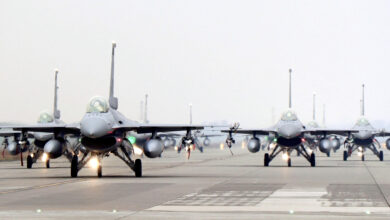Japan looks to boost naval capabilities in face of emerging China submarine threat
One of Japan’s largest warships joined America’s only forward-deployed aircraft carrier, the USS Ronald Reagan, in a joint exercise in disputed Asian waters last week.
The two vessels were joined by other ships from both countries in an exercise in the South China Sea. The training mission is the latest in a series of joint training exercises that Japan has conducted in the past few months as it looks to expand the capability and capacity of the Japanese Maritime Self Defense Forces.
“The Navy and JMSDF regularly fly, sail and operate together with other allies and partners to promote security and stability throughout the region,” the U.S. Navy’s 7th Fleet said in a statement.
The JS Izumo is one of two helicopter destroyers in the Japanese fleet. The vessels will soon undergo upgrades, turning them into pocket aircraft carriers capable of launching the F-35 Joint Strike Fighter.
During U.S. President Donald Trump’s recent visit to Japan, Tokyo announced a new order for 105 F-35 joint strike fighters.
“In the past such vessels have been at the core of Japan’s ASW efforts,” said Jeffery Hornung of the RAND Corporation, using an acronym for anti-submarine warfare. “It is unclear what Japan’s plan is regarding the F-35 unclear and to what extent the F-35 will be involved in ASW mission or which variant (the F-35B or the F-35A) will be used in this role.”
The F-35B is the short takeoff and vertical landing variant of the F-35 used by the U.S. Marine Corps. Regardless of how Japan chooses to deploy the new fighter, expansion of Japan’s ASW capacity remains a key focus.
The recent joint exercise with the USS Reagan occurred just a day after China’s sole aircraft carrier sailed through the strategic Miyako Strait. The strait, located between the islands of Miyako and Okinawa, is one of the few international waterways through which the People’s Liberation Army Navy can access the wider Pacific Ocean.
China’s navy is undergoing an unprecedented expansion campaign that will see China surpass Russia as the largest navy in the world in terms of frigates and submarines by 2020 if the trend continues.
“From advanced patrol aircraft to the procurement of RQ-4 Global Hawk – an aerial drone – Japan is increasingly investing in maintaining its premiere ASW capabilities,” Paul Hornung said.
Boosting Japan’s anti-submarine warfare capabilities
In November, Japan signed a contract worth nearly half a billion dollars for three Northrop Grumman RQ-4 Global Hawk drones.
In March, Japan launched its second Asahi-class guided missile destroyer, christened JS Shiranui. Both vessels in the class are designed explicitly for ASW missions.
The core of Japan’s ASW capacity is perhaps its indigenous Kawasaki P-1 maritime patrol aircraft. With 15 in its fleet already, Japan plans to purchase 12 more of the aircraft in the next five years. These purchases are part of some $243 billion Japan plans to spend on defense over the next five years.
What will happen to Japan’s outdated weapon systems is unclear, but Tokyo has a clear interest in ensuring its allies in the Indo-Pacific expand their ASW capabilities as well. The P-1 is one of only a handful of Japanese weapons systems that have been marketed for export.
“The Japanese constitution limits its ability to sell weapons or old equipment,” says Hornung. “However it has gifted at least one vessel to Indonesia and trainer plane to the Philippines. Instead of arms transfers, Japan has increasingly focused on capacity building and training [exercises] with other Indo-Pacific nations.”
In addition to training with the USS Ronald Reagan, the JMSDF have had a busy schedule of training this year.
One exercise involved the U.S., India and the Philippines in addition to the JMSDF in a “Group Sail” in the contested South China Sea. In another, Japan was joined by the United States, France and Australia in the Bay of Bengal for the inaugural La Perouse exercise in mid-May.
Later that month, Japan, the U.S., South Korea and Australia held a first-of-its kind training exercise, Pacific Vanguard, near Guam.
“Japan is certainly among the leading military powers in terms of ASW capabilities, but … Chinese submarines are one small subset of the larger maritime problem for Japan,” said Mike Bosack, a Special Advisor to the Yokosuka Council of Asia-Pacific Studies.
Japan’s Air Self-Defense Force lost one of its F-35A jets in a crash at sea earlier this year, sparking concern that the aircraft’s highly secretive components could be discovered by Russia or China.












